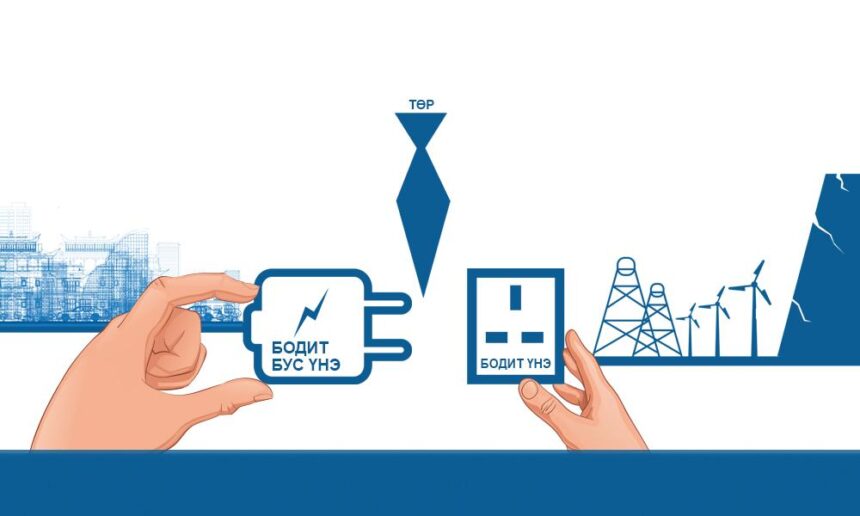Development without electricity does not exist. In Mongolia, 15% of the total population is living without electricity, 70% is living with an outdoor wooden toilet, and one third is living in poverty.
The underlying reasons are energy shortage and its unreliable supply. Instead of holding an extensive discussion and remedying the situation, the Mongolian public has wasted 20 years by dividing and running into battles from election to election, believing in empty promises of politicians, and psyching out along with those politicians.
Mongolia is unable to provide the entire population with sufficient and reliable energy, yet it has abundant sources of energy such as coal, sun, and wind. Despite the energy shortage, the authorities began fooling us by claiming that Mongolia will supply electricity to the Asian continent. In reality, the energy policy without fuel is concealed behind such claim.
Energy supply and tariffs
The energy sector was partly unbundled, racing with the new century. Ever since, the past events have shown that the Mongolian energy sector is profitable for the government, but harmful for the people. The vertically integrated structure of the energy sector was unbundled. In accordance with international practice the generation, transmission, distribution of power was separated and converted to state-owned stock companies. Following the amendment of the Law on Energy in 2001, the Energy Regulatory Agency was established. Ten years later, due to a new amendment, the Agency was renamed to Energy Regulatory Commission. The primary goal of the Commission is to issue licenses to operate in the energy sector, to review and approve the tariffs between the license holder and consumer, to provide equal protection of their rights, and to create necessary conditions for fair competition. The question arises how 20 years later the energy sector remains outdated, operating with a deficit and with no efficiency as if it were an ownerless property.

In the previous year, energy consumption was 8.3 billion kWh (Kilowatt hour) in Mongolia. If we break down the supply, the energy production and imports constituted 80% and 20% respectively. It discloses the fact that Mongolia does not have an energy storage. The age of existing five power plants and the transmission-distribution lines is between 32 to 57 years and 30-60 years respectively. Regardless, during winter peak hours power plants are operated strenuously at their full capacities.
The government is not troubled with enhancing the capacity and efficiency of coal mines, power and heating plants. Consequently, 52,166 enterprises, 633,071 households are facing the risk of a power cut or of freezing if there is be a minor incident at the plants.
The core reason lies in unrealistic prices and tariffs: The price of electricity is 22% lower than its cost, whereas the price of heating is 2-3 times lower than the cost. For instance, the government offered a discount amounting to 62.7 billion tugriks and in households, the electricity price was 0.32-3.0 times lower than the cost last year. In 2005, the electricity and heating bills constituted 15% of household income and in 2018, the percentage was at 6.2 %. The provider in a four-member household pays on average 302 tugriks for electricity, 500 tugriks for riding a bus, and 820 tugriks for cell phone use in a day. The business electricity bill is 4 times lower compared to other countries.
As the bills showed considerably lower amounts than the actual costs for many years, unpaid invoices and debts are accumulated between power plants and coal mines. Moreover, they both became outdated and are not able to secure investments, parts, and tools on time. By the third quarter of 2017, the Baganuur Coal Mining had a debt collection and invoice factoring amounting respectively to 142 billion tugriks and 8.9 billion tugriks. The Shivee-Ovoo Coal Mine has debt and invoice amounting to 103 billion tugriks and 5.8 billion tugriks respectively. Recently, both companies begged the cabinet to cover their deficits through the government budget immediately, so they could carry out winter preparations. As profits are entirely ignored, an interest to increase the cost is dominating in the energy sector.
Fifteen hundred people are working in the fourth cogeneration plant whereas 10 times less people work in western plants with similar capacity. The mining license of “Baganuur” LC was “given” to “Altain Gyant” LLC in 2012, and recently was transferred to “Erdenes Mongol” LLC. “Altain Gyant” acquired 49% of “Erdenet Mining Corporation” through public money. However, it was revealed that the shares were acquired by Ts. Purevtuvshin, an owner of company called “Mongolian Coal” with close affiliations to “Mongolian Copper Corporation”.
Necessity to set free price system and sell the shares
Not only vertical, but also horizontal unbundling is necessary in order to avoid risks in the energy sector and to fully and reliably meet energy demand of the population. Especially, it is crucial to encourage the formation of several new plants and distributors to invest in electric transmission companies, increase the capacity, and to improve the quality.
Hence, making it essential to set a price with profit margin of 10% after cost deduction, and measure performance of the mines and power plants by its profits. Furthermore, a cost monitoring system can be established by selling 51% of shares of all energy companies on the stock exchange with a condition that a buyer cannot purchase more than 5% of the shares.
It is straightforward that investors and new players only enter into profitable sectors. Even though numerous licenses to build new power plants exist, other plants than Oyu Tolgoi’s Tavan Tolgoi cannot be implemented at the moment. A clear example is the 5th power plant which has been in discussion for 20 years, and while the footings were installed 10 times, yet the project has not come to light. The government authorities and the companies they are connected to, attempt to involve in projects with available investors and investments in the energy sector. As a result, whenever the government was replaced, the political parties cross swords and eventually the project died out.
Let’s learn from our bitter experience and transition to market evaluation so we can fuel the energy sector and economy.
2019.10.16
Trans. by Riya.T and Ariunzaya.M












